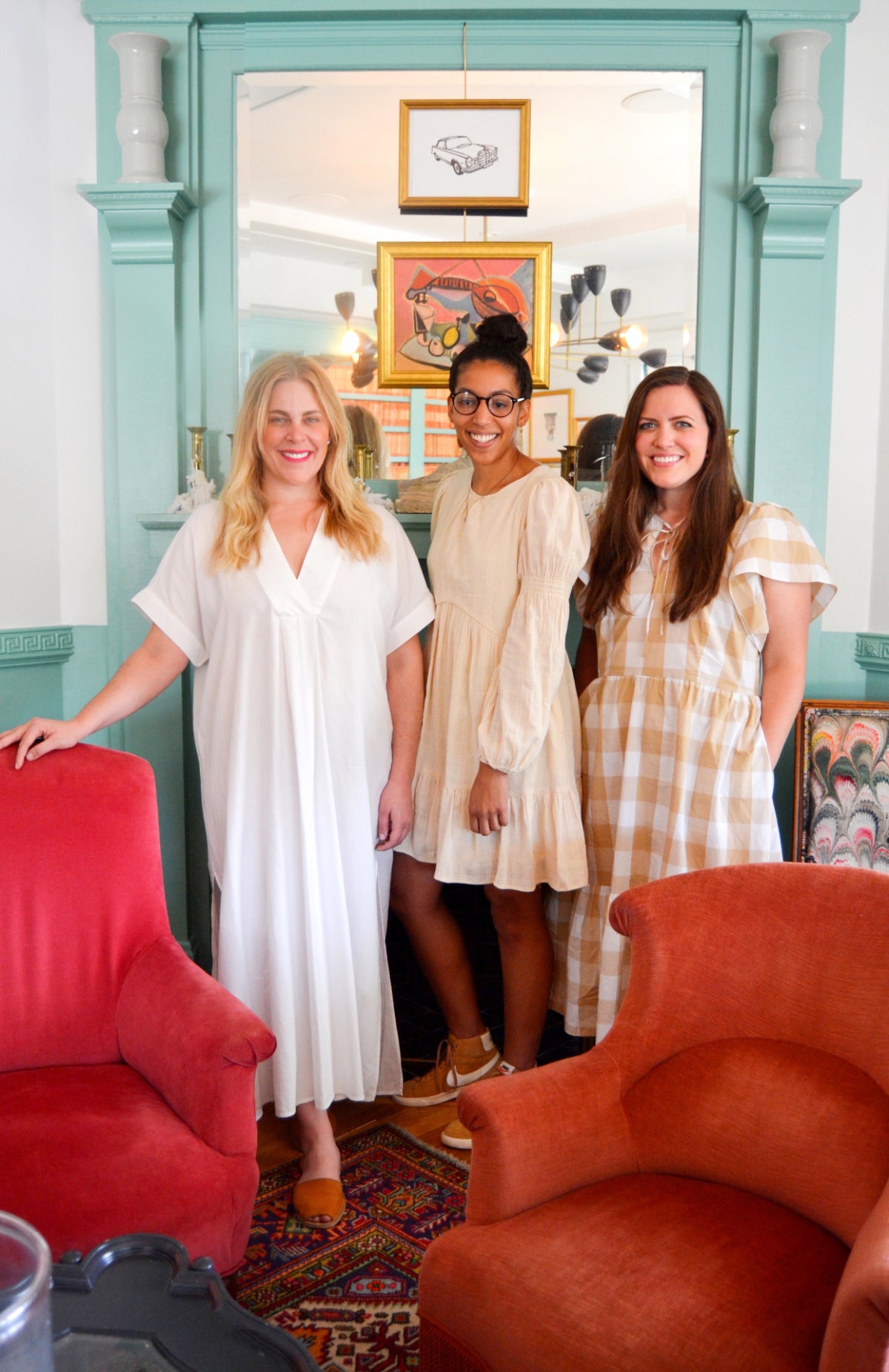The 50 States Project is a yearlong series of candid conversations with interior designers across the country about how they’ve built their businesses. This week, the team at Oklahoma City–based Pastiche Studios—founder Sara Kate Little, interior designer Oby Okeke and project manager Megan Miller—tell us why they look for clients with collections, what role color plays in their design process, and how a project management platform transformed their workflow.
What was the journey to launching the studio?
Sara Kate Little: I founded the company 10 years ago out of design school. My training was geared toward retail design and hospitality with the intent to work at a big architecture firm. Ten years ago, boutique firms—at least in Middle America—were few and far between in terms of the aesthetic I was drawn to. But it wasn’t really until I interviewed with a large architectural firm that I realized I didn’t want to work in a cubicle for the rest of my life and that I enjoyed the tangible aspects of design. I got a lot of encouragement from family and friends that I could stand on my own and make a living doing what I wanted to do. So I set off and said yes to anything and everything, which started off as residential and then gradually turned into some commercial work, as well.
Fast-forward 10 years later: We undertook our first large-scale hospitality project in the form of a 36-room boutique hotel with a bar and restaurant that opened last year. Through that process, I realized that I had a member on my team who was really well suited to move forward in the direction that we wanted to grow the company and start adding some additional people. So we rebranded from Sara Kate Studios to Pastiche Studios, where we’re a more well-rounded team and people take on work on their own and delegate confidently. We just rebranded a few months ago, but our team has been in place since Oby joined in February. We’re in a transition period, for sure.
Did you have any doubts about no longer having the business named after you?
Little: I had no doubts. As we’ve grown and with the projects that we’ve taken on, I think it’s been obvious [that it’s a team effort] for a long time, and our clients have gotten to the place where they are happy to embrace the fact that it takes a village to make these projects come to life.
When you think back to the beginning 10 years ago, what were the steps you took before you made your first hire?
Little: As our workload grew, and as I started to get into more custom, it just [took] more people. The first official employee was maybe two years in, but I’ve always liked us being small. Finding the right people who understand your aesthetic and you feel confident to interact with clients or delegate to, that’s not something that you can just find at the drop of a hat. So we’ve been really thoughtful about who we’ve added to our team and the projects that we’ve taken on.
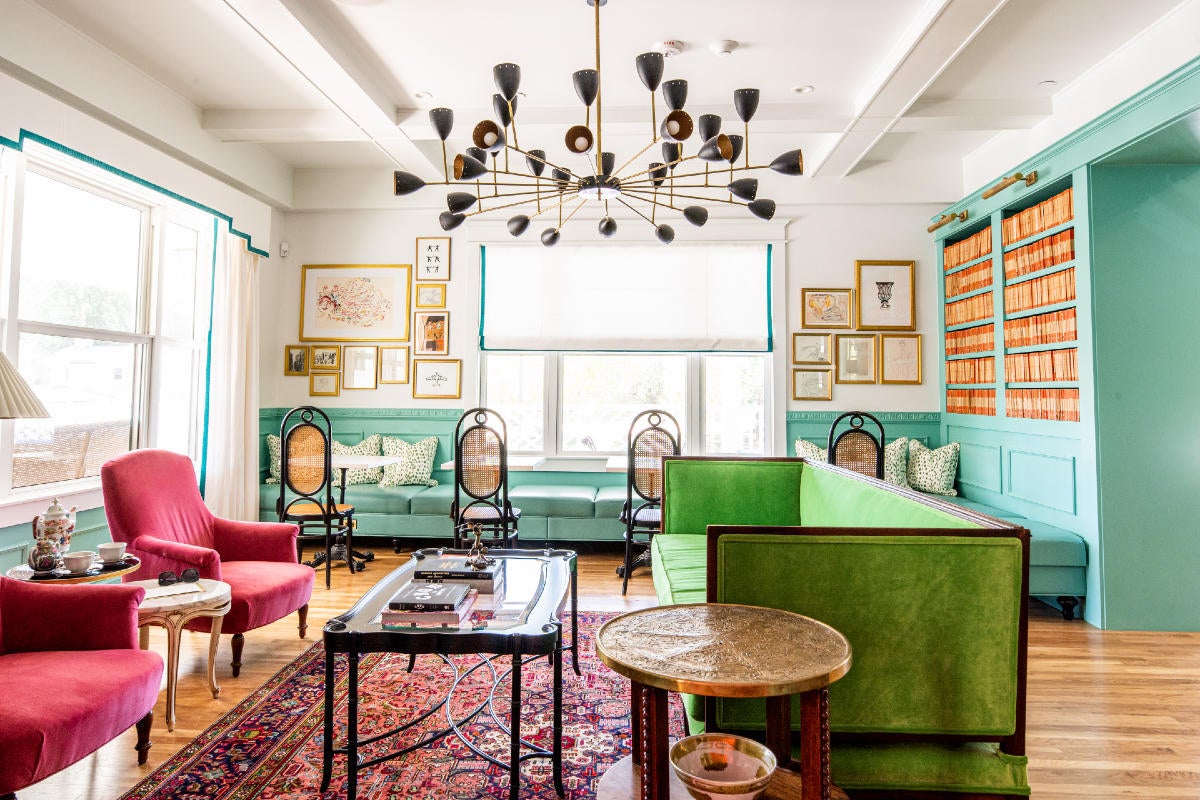
For Meg and Oby, when did each of you join the firm, and what are your roles?
Megan Miller: I have been with Sara for about three and a half years. Initially, I started in a role that was more about having extra hands on deck for install days. Probably a year after I started working for her, I stepped into a little bit more of a full-time role, managing upholstery and orders and things of that nature. I’ve learned a lot about electrical—and about a lot of the things that aren’t always pretty but are important. Now it’s more of an overarching role managing our projects and vendors, making sure our clients are on track and taken care of. We all do a little bit of everything.
Oby Okeke: And I started in February, so it’s been about seven months. Initially, I started doing all this stuff in the background—a lot of drawings, elevations, floor plans, furniture plans. But pretty quickly, I moved toward managing small jobs and helping with installs and coordinating with clients and vendors, running small errands, helping fix all the little details. Like Meg said, we all do a little bit of everything.
Little: I think too, as we’re trying to problem-solve, [it’s important] for all of us to be willing to get our hands dirty. Especially over the past year and a half, things have gotten more complicated for designers than they ever have been in my career. So being able to have team members who can help think through solutions, then draw an elevation or custom sectional ... If upholstery is going to take a year for us to get, can we have someone locally do it? We’re really having to get creative in ways that I never anticipated we would.
I love that all three of you mentioned everyone had a hand in everything, but how do you divide and conquer?
Miller: The benefit to everyone being on every project is that we all have very different perspectives and experiences. Often, where I get stuck on a problem I’ll present, something may pop out much clearer to one of them. It’s really helpful to have a group that can play off each other’s ideas.
Little: We’ve been using the project-management app Asana for three years. I can’t live without it. It’s internal and external—we have team boards for the three of us and any of our vendors, builders and clients that are allowed in it. So we have boards for each of our clients that keep everything straight, and we can upload documents, renderings and selections.
Instead of email?
Little: Yes. We tell them not to use email once they’ve signed our design agreement.
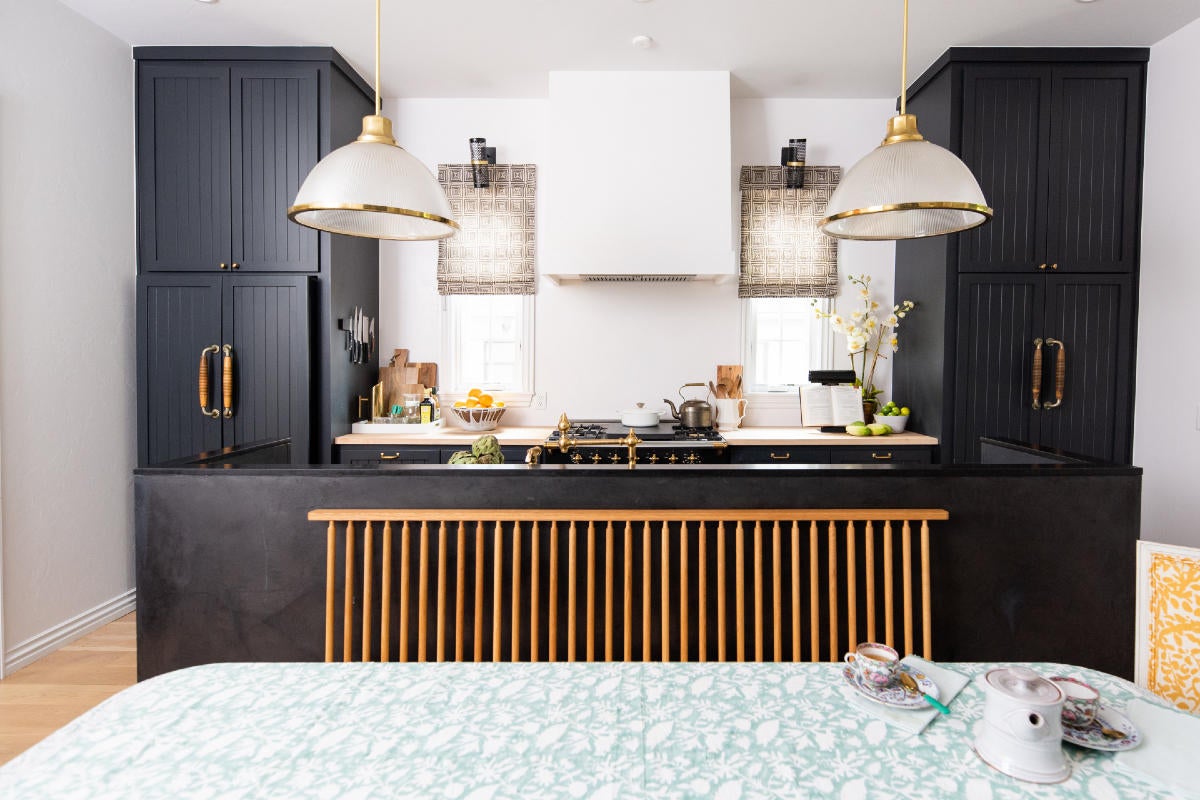
How does that work? I’m asking as someone who would love to escape from my inbox.
Miller: We use email with vendors and ordering, or for potential clients. But once they are an actual client of ours with a signed contract, then we change everything over to Asana and create a workflow from their priority list. Then we can assign things to each of us and assign things to clients that we need feedback from or if we need some homework from them on, like: “Hey, take the dimensions of that one dresser that you want to keep that was your grandmother’s,” or whatever. It keeps everything all in one place, and you don’t have to sift through your email inbox every day.
Little: And you can include the information for a specific item. As the project grows, we’ll have tasks assigned for each room, for instance. And there may be a dozen or more comments [updating the status on an item, but] it doesn’t actually get checked off until it’s done, and it eliminates a lot of the communication in terms of clients saying, “Hey, just checking in on where this is.” Especially if we have a dozen projects going with God knows how many outstanding items. It’s been a godsend—and it’s the only way that we keep all of our million ducks in a row.
Was there any client pushback on that? Are there some clients who just want to communicate via text or email or phone?
Little: There are some clients who honestly don’t really care about checking in, which is funny. They’re just like, “Yeah, we’ll see it. Great—we’re excited about it. It’ll be here whenever it gets here.” So we have some people who are set up on this system and I don’t think have ever opened it. On the other end of the spectrum, we have some clients who use it obsessively. It is really nice because clients typically are thinking about and want to talk about their project whenever they’re not working, right? So it’s in the evenings and on the weekends. And I have three young babies and my husband to contend with on the weekends. We can’t always make ourselves available for a text or phone call.
If there’s an awkwardness to learn how to use Asana, or a little bit of pushback, it happens in the beginning. And then they start to see, “Oh, this is super helpful,” because they can actually see it was assigned to me, and then I reassigned it to Meg, and then Meg did what she needed to do and reassigned it to Oby. And so they can actually see, “Oh, this is getting worked on.” And there are comments added and documents being uploaded.
Okeke: Or quotes. It’s really helpful if we’re doing something custom or bidding out specifics of a job. It’s nice to be able to get all those numbers, put them in a task, assign it to our client, and then they have the ball in their court at that point. They have time, they want to look over all their options or decide when they’re ready to move forward with something and then they can type “approved,” and send it back to us, and we can move ahead.
Little: Even at the end of a project, we put punch lists on there. We’ll say, “Hey, as you’re living here and you see things, please add them to the list.” So you can actually take a photo within the task. And it might be pointing to the wall and saying, “Hey, this needs a touch-up.” Or “Hey, this little sconce needs to be adjusted.” For every step of the project, it’s really helpful to have the documentation in text or photo, or attach a PDF of a floor plan, or receipts, or whatever.
Okeke: And even if the client doesn’t use it, we still use it heavily. If I see that Meg is working on the kitchen cabinets project because something is assigned to her, then I can easily ask her a question. Whereas if we weren’t using that, I would have to figure out who’s working on what exactly. So, it’s super helpful for us in-house, too.
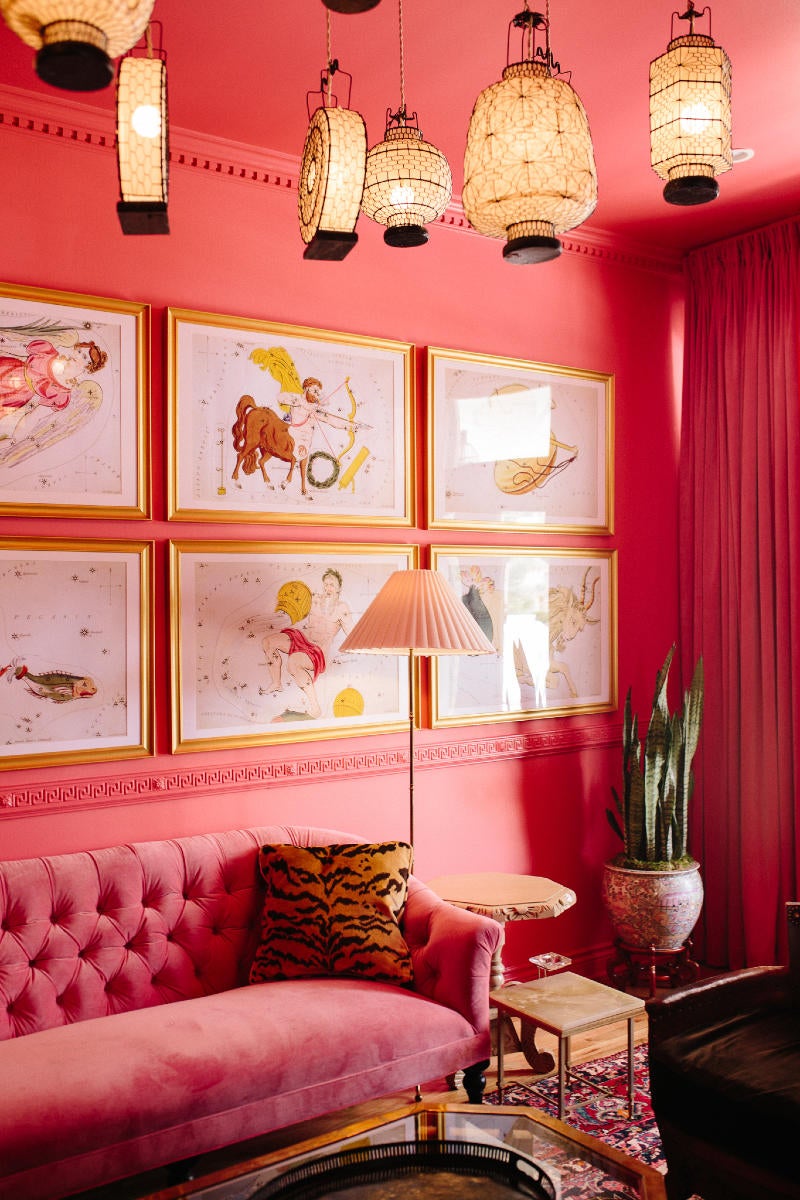
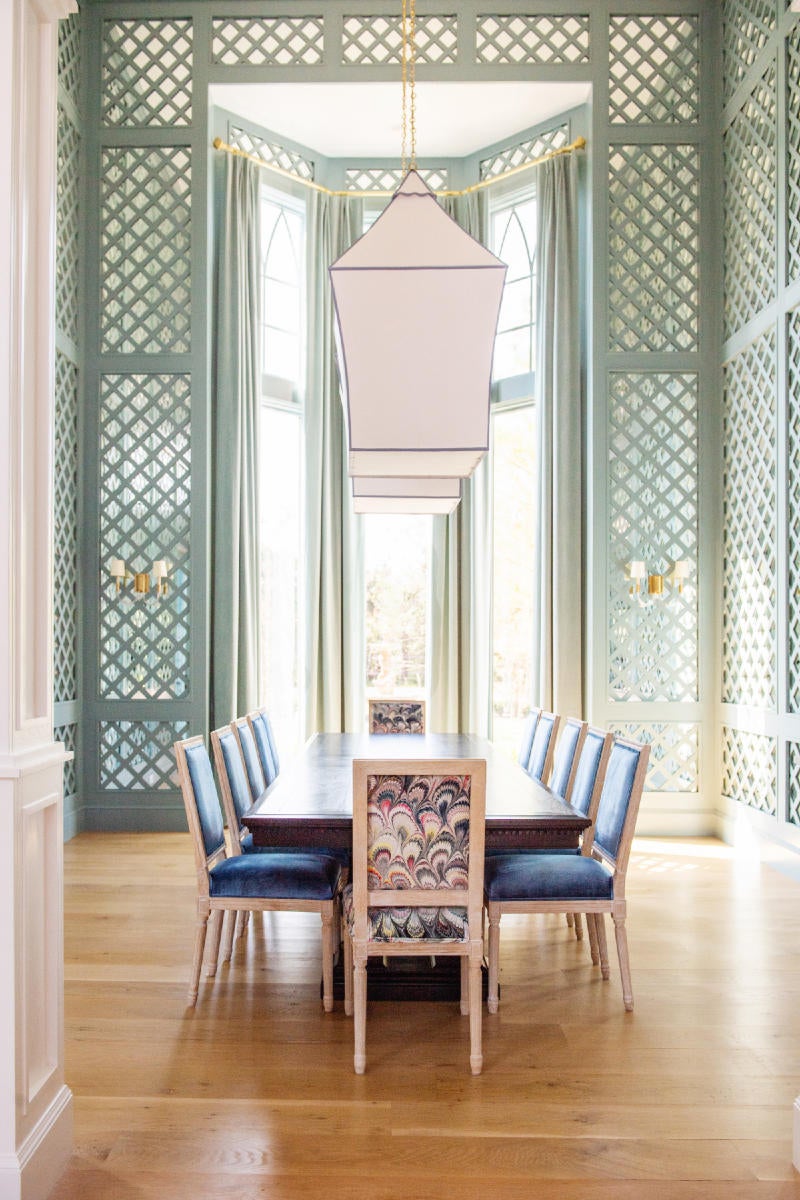
Are you all collaborating these days in person, or is this a virtual thing most of the time?
Little: We are in person together. ... Over the span of the last year and a half, we tried to ebb and flow with case numbers and our comfort level with being on job sites or even our clients’ comfort. We just had a client who was out of town for two months while we boxed up everything in their house, repainted the entire interior, wallpapered, and started to move in new furniture. They’re very sensitive about COVID and want everyone to mask and limit the number of people that are around. So for them, that was a really desirable thing to do—to be able to go away and say, “Let’s let these things play out while we’re not here so we can still get it done as efficiently as possible.”
I know you said projects vary in scope, but about how many projects are you typically working on at one time?
Little: I was counting it up yesterday. On our project list, we have 14. We have, I would say, maybe six clients we’ve been working with [on a continuous basis] for two-plus years. Those relationships are super special because we know each other really well. We know what to expect. In the past year, with everybody being home, we have some clients that say, “Hey, now that we’re home more, we would love to adjust this and add that.” So we have some people where it’s a smaller scope, but because we know them, we love them, we’re happy to continue to help in whatever little way we can. As far as projects that we’re actively involved in every week—how many would you say, Meg?
Miller: I’d say four to five that are pretty time-intensive right now, and then the rest are trickling as needed.
How do new clients find you, and how do you decide what you say yes to?
Miller: The majority of our clients are referrals either from previous clients or other local industry relationships. As far as how to know who to take, I think that it tends to just be a feeling of similar goals and outlook, and someone that appreciates the history of their home and the pieces we’re going to bring in, and a willingness to try new things and push their boundaries a little bit.
Little: Also, we love color. In the past year, we’ve had a handful of interviews with clients and their home is completely neutral and they would like it to stay that way, which is totally fine. But that’s not the work that I enjoy doing and that’s not really what’s in our portfolio. I really just want clients that align with us in some way or another. When I walk into a client’s home and I see a little collection of something, to me, that’s affirming that this is someone that is maybe nostalgic in some way. Do they love to travel or do they have close ties with their family heritage, where these are family pieces? To me, a collection is something that really excites me. It’s a flag that this could potentially be a really great fit. It’s so little, but if I see a collection of something, that makes me feel like it’s a good fit.
When I say no [to a project], part of it is a feeling. I think you need to listen to your gut and align with your client and be able to meet expectations. We were talking to a client this week and they were saying, “Listen, I know lead times are all over the place and I know prices are all over the place—we’re not going to hold you guys to something that you can’t control,” which is wonderful to hear. I’ve always tried to be really upfront with clients about what we can and can’t do, and we’re willing to pivot and get creative. In interviewing a client, if it’s clear from the beginning that you can’t meet expectations or you don’t align in terms of aesthetics or outlook, it’s definitely something you shouldn’t embark on.
Can you tell me a little bit about the design scene and community in Oklahoma City?
Little: Look, when people think of Oklahoma City, they don’t typically think of good design. That said, where we are, we’re nestled in between a ton of historic neighborhoods that are, for the most part, pretty thoughtfully preserved. Our clients by and large are very nostalgic people who care about quality, but want their home to be livable. I think people are surprisingly well-traveled compared to in many other cities in the country. The cost of living is also fairly low compared to other places, so people can live relatively modestly and really put an emphasis on travel. It’s really helpful to [have clients with] exposure to the aesthetic that is beyond our boundaries.
In terms of other [industry] people in the city, it’s a very small town, and there are some other really talented designers. I wouldn’t say that there’s a ton of overlap aesthetically. I think everybody has their own style, which to me, is very cool. We could all have the same problem and solve it in a completely different way. It is cool and affirming to hear people say, “I love your style and that’s why I want to work with you.” Not just, “I need help with something. Can you help?”
There are some really young designers up-and-coming, which is super cool. I mean, 10 years ago when I was graduating design school, creatives didn’t see themselves in Oklahoma City. They wanted to go to bigger markets. That makes me really excited for our city, that young people want to stay and make a mark.

If it feels like everyone has a different style, how do you handle clients who are coming from working with a different designer in town?
Little: We’ve had some interviews. We typically turn them down. To me, that’s another red flag. Why did it not work? What was the problem? What expectations weren’t met? I want to have a good working relationship with our clients. If you were working with someone whose aesthetic is farmhouse design, that’s not our style. There’s nothing wrong with that—it just isn’t our style. So if we get an inquiry from someone who worked with another designer who has that aesthetic, it wouldn’t be the right fit.
Where do you go for inspiration?
Little: We all like to travel. We are big on taking pictures of things anywhere and everywhere that we go. And we also are really big into the history of design. We’ve been going through a little less Pinterest and a little more books and old magazines and finding inspiration in really historic design. Especially as we tackle historic projects, houses that are built in the ’20s, we don’t want to erase that history, so we study design from that time period.
A big project that we started about two and a half years ago—right after I accepted that project, I went and took one of Rita Konig’s workshops at her home in London, which is what caused the British obsession that we’re seeing play out in the project now. I had popped into Soane Britain and Penny Morrison and started collecting all these textiles. Two and a half years later, we are still weaving that thread into our projects.
We also enjoy the learning aspect of design, and I never want to feel stagnant in our aesthetic. Collectively, we are nostalgic in different ways. The idea is to find something that excites us and then mesh it all together, which really is where pastiche comes from. I mean, it can be used as a term that means “copy,” I think, if you’re really not digging into the real meaning of the word, but truly it’s about a combination of things. And also, if you dig deeper into the description, it means “by a combination of artists.” In everything we do, we seek to find things that we’re excited about, put a spin on it, and create something that feels like it has some grounding historical reference, or something that’s been seen, but done in a different way. It’s a really fun challenge to take something from the past and reinvent it and do it differently, but in a way that still pays respect to the time period that piece or idea came from.
What about shopping? Where do you go to source?
Little: We’ve been to High Point. We go to the design center in Dallas if we’re down there picking up antiques. The James showroom is down there, which we love. And over the past year and a half, we have gotten really crafty about utilizing online resources more than ever, because there are so many options. You don’t have to worry about personal contact or travel time. We are also shopping auctions more than ever. We go to estate sales if there’s one that piques our interest. But most of our shopping is really done in town or online—Chairish, 1stDibs, LiveAuctioneers.
Okeke: We have some great reps with our favorite textile companies either bring us things they know we’ll be excited about or will ship us a new fabric line, things like that. But we also find a lot of joy in discovering small production companies and places that aren’t necessarily repped by large showrooms, and forming some direct relationships there. It brings a nice variety to our libraries.
How have you approached billing, especially in the last year and a half?
Little: We’ve had a handful of projects where we’ve done flat rate, whenever it made sense, when the scope has been really meticulously defined. For everyone else, it’s been hourly. I’ve always said we’ll help as much or as little as you want. We have tried to be really upfront about outlining anticipated hours on the front end, but if you’re indecisive or if you want to see a lot of options and get really nitty-gritty about outlining a working budget, those things take time. Luckily, we haven’t had too many hurt feelings about it.
Miller: It’s all about expectations and communication. It’s about having the discussion upfront and making sure everyone’s on the same page and then working from there. No two projects or clients are identical.
Little: Three years ago, almost all of my projects were retail or restaurant. Luckily, in the time of COVID, the projects we’ve been working on are personal projects that are very emotional to the client—they’re home. We try to create transparency and a road map as best we can, but things are changing. For a while, it felt like things were changing every day, and we don’t have control over that. [But] for the most part, our clients have been doing design and making decisions because it’s their home and they want a safe, comfortable space, and they’re actually home now to be enjoying it. They see that value, regardless of a variant in costs.
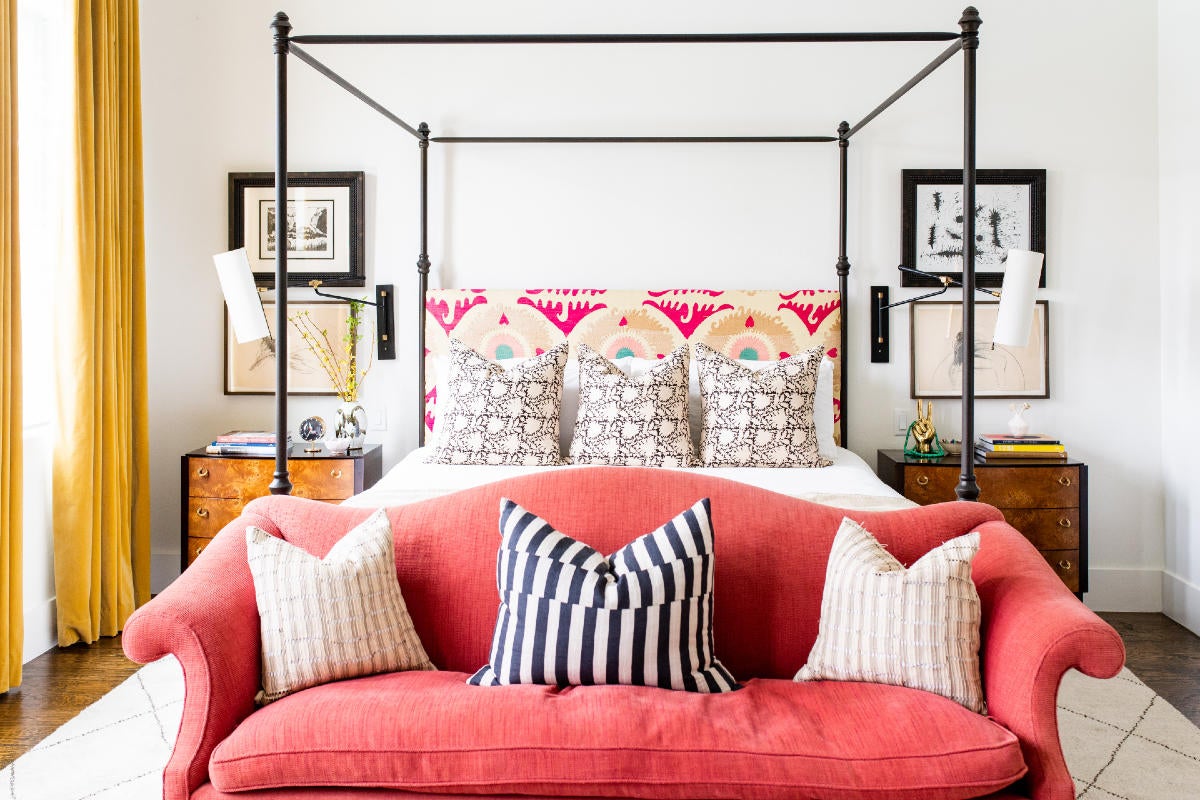
You mentioned doing as much or as little as the client wants. Did you have the experience of clients not finishing projects?
Little: I experienced that in my first year or so of business, but have not since then. With clients being home now, there’s always a punch list, and it drives me crazy. Like, Oh, my gosh, there was a hiccup and we were installing a jib door on a wall that we realized in the historic home had originally been an exterior door. So the original framing from God knows how long ago didn’t work for what we wanted to do. It became very clear to everyone that this is going to take some more time to work through and we have to deal with this problem that we didn’t know existed. Ultimately, when clients start to get a glimpse of that, they’re like, “You know what? You’re doing a great job. This is all so stressful and I would just rather not know about it. I trust that it’ll be done well and thoughtfully.”
Honestly, I think part of [figuring that out] comes with the interview process. If you have a client who from the get-go shows some issue with hourly billing or commission, or says, “Can you do all the floor plans and then I can do all the ordering?” To me, that ultimately shows they don’t respect your time or what you’re bringing to the table. So that’s something that hopefully shows itself early on in the interview process.
When you look back to starting the firm, what is the biggest thing you wish you’d known then?
Little: I’d say, “You’re going to figure out how to do this work.” Knowing why I was embarking on this type of work was never the issue—I was fully aware how sacred and intimate the concept and design of home was to both myself and others. I had the training to know how to do floor plans and codes. I had a hunger for antiques and to learn about the history of design. I had the gumption to be an entrepreneur, but I also had so much to learn about processes, billing, timelines and scheduling.
I had a lot to learn about trying to execute the details in construction that many of the men we were working alongside saw as critical or frustrating. I’ve been told more than once: “You are asking too much for this to be level, or for there to not be drip marks,” like it was unreasonable to ask for it to be done well. I think in my early years, I took that really, really hard. I was trying to figure out how to navigate it and trying to create a beautiful, thoughtful project—a safe space for our clients—and somehow make a living doing it, have it be on schedule, and all the other things that come into play.
There were many times I encountered a situation that I wasn’t certain how to handle, and I approached it as best I could. I got advice from people I trusted. I researched. I ultimately knew more about how to handle the situation after it had passed and was much better at handling it the next time. Again, I would tell myself that I would figure out how to do it successfully but I would need to get my hands dirty, to learn from my mistakes, to get organized, to ask for help and to find people to labor in the work alongside me. I am amazed at people that can successfully and happily take on this work as a business of one. There are so many loose threads to tie up, so many decisions to make, so many skills needed to pull off a project. My life and work is much more satisfying and well-rounded, and I believe my clients also benefit greatly, from our firm working as a team.
Looking ahead, where do you see the most opportunity?
Little: We enjoy working on a mix of commercial and residential work. We did Bradford House, [a boutique hotel in Oklahoma City that] opened a year ago. I’m excited to do some more hospitality projects. I think current and future clients have realized over the past year how important home is, how it’s worth investing in and why quality matters. Looking to the future, people are going to have a hankering to experience spaces that don’t feel like home—that feel like an escape from home.
We did a pink room at Bradford House called the Lantern Room. It’s the pink colors by Papers and Paints, a British paint company. Patrick Baty is a color consultant on basically all of the important historic buildings in the U.K. But this color is called Manhattan Pink, and it’s just wild. Everyone was so scared of it. I said, “Guys, let’s just get it up and get all the furniture installed. If everyone hates it, then I will reconsider, but just let me see it to its end.” After doing it, actually, men love that room, which is so funny to me because, of course, all of our male clients say, “I love navy and brown and gray.”
Okeke: They’ll say, “Just not too much pink!”
Little: Yeah. They want something more subdued, but that’s a room that you don’t have to live in. It’s better because it is completely different than what someone would pick for their personal residence. It feels like an experience. It’s even more exciting because it’s just so unexpected that you would enjoy, that a man would enjoy, that space. They go in and they’re like, “I want to drink my bourbon in here.” For me, that’s really exciting and fun to be able to witness that interaction.
Homepage image: Sara Kate Little, Oby Okeke and Megan Miller | Courtesy of Pastiche Studios
















